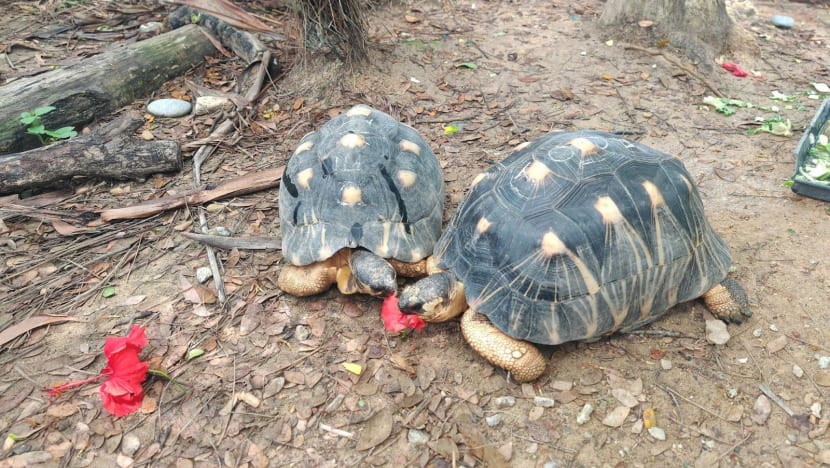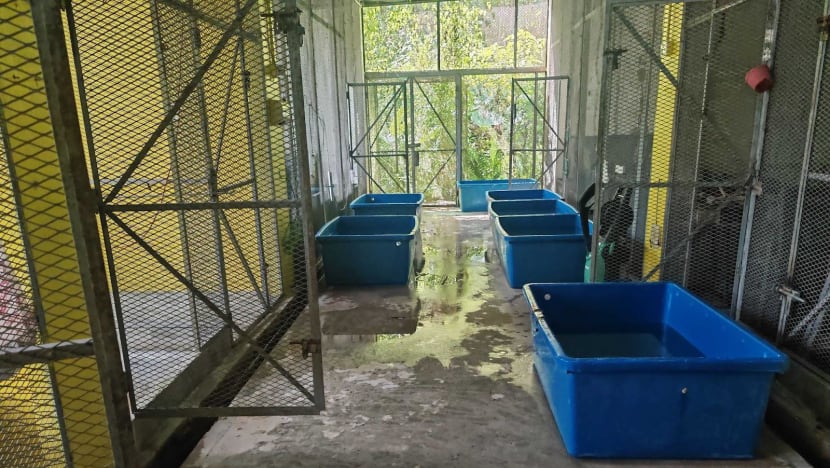Land poisoning took away much of its original space. Years on, ACRES finally gets green light for expansion
The wildlife rescue centre in Sungei Tengah is currently using only a quarter of its land after a contractor poisoned the rest more than a decade ago.

Caption: Google Earth images showing the land occupied by ACRES’ in 2009 (left) compared to its current premises where the area behind is a forest. (Images: Google Earth)

This audio is generated by an AI tool.
SINGAPORE: When Mr Louis Ng set out to build a wildlife sanctuary in 2006, he never expected the cages, enclosures and ponds in 1.5ha of land would be left in disrepair for more than a decade.
The founder of Animal Concerns Research & Education Society (ACRES) had a dream to give animals a second lease of life amid the verdant nature of Sungei Tengah.
Enclosures for tortoises, cages for iguanas and monkeys, and ponds for turtles - the fruit of volunteers’ labour - came to nought when brackish water started seeping out from the land.
“That was probably one of the worst times of my life,” Mr Ng told CNA.
The site had been poisoned by a contractor ACRES had engaged for construction works, and was deemed unusable. ACRES only managed to salvage a quarter of the land where its office, education centre, animal facilities and staff quarters, now stand.
“All these dreams were about to come true. All of a sudden they have to be demolished. It was horrible,” said Mr Ng, who is also a Member of Parliament.
Worse, the wildlife advocacy group could not recover a single cent from the contractor, which ACRES took to court in 2008.
The wildlife rescue centre at 91 Jalan Lekar was just recently given the green light to expand to its original size - four times the 0.5ha it currently occupies.
“We are thrilled to announce that we have an official green light to proceed with the use of the back area,” co-CEO Kalai Vanan Balakrishnan told CNA.
“This is, of course, subject to conditions, but we are relieved that we can finally slowly get to work to utilise the back area.”
However years of disuse have left the 1.5ha behind its current premises overrun with foliage. Only a small footpath winds through dense vegetation, past structures that were abandoned after initial plans.

HISTORY OF THE LAND
ACRES engaged A.N.A Contractor to construct its shelter, including clearing vegetation, as well as filling and levelling the earth to build several structures on the plot of land.
Construction began in January 2007 but was beset by problems, including delays in completion. Then, wood chips used as a landfill led to a foul smell and a discharge of brackish water from the site. It polluted the surrounding environment and contaminated Kranji Reservoir.
ACRES sued A.N.A for breach of contract and negligence in 2008 and was awarded S$26.5 million in damages in 2013.
The monumental sum included the cost of cleaning up the toxic waste and installing a special tank to stop foul water from entering Kranji Reservoir. However, ACRES could not recover any of the sums from the contractor and its director, Tan Boon Kwee, who declared bankruptcy in 2012.
In another twist, Tan was hauled to court after dissipating his money instead of paying damages to ACRES. He was jailed for 14 months in 2015 on charges related to fraudulently transferring money.


The pollution forced ACRES to abandon the site and its plans for a large wildlife sanctuary for the next 15 or so years.
WILDLIFE CENTRE RESTRICTED TO SMALLER AREA
The centre officially opened its doors to a much smaller area in 2009. Its current 0.5ha of land contains an education centre, facilities for animal quarantine and rehabilitation, and staff and volunteer quarters.
Mr Kalai said the centre has managed to improvise, but that the continued welfare of the centre's 125 "permanent residents" - exotic species that board there for the foreseeable future - necessitated an expansion.

"The inability to use this portion of the land crippled us heavily. Being resilient, we coped and improvised and have continued to expand our ability to house and rehabilitate animals,” he told CNA.
"The usage of this land is key to us being able to help more animals."
The number of such residents has swelled from 81 in 2019 to the current 125.
These include scores of tortoises, snakes, green iguanas, geckos, a savannah monitor and a stowaway bonnet macaque.
Among these, 31 pig-nosed turtles have lived at the rescue centre for years, a few from as early as 2009.
Each turtle - the size of a large dinner plate - is male and very territorial, said Mr Kalai. Each is currently housed in its own tub indoors. Staff take them out one by one for sun baths.
With the expanded space, Mr Kalai hopes to rehome the tortoises in outdoor concrete ponds.
"If they are outdoors, they get sunlight, we can grow aquatic plants. We can try putting them together. It will be a game changer for the way we work, how our manpower is used, and also for the animals," he said.


Mr Kalai estimates that the shelter is at around 95 per cent capacity for the animals it houses.
There are significant barriers to repatriating exotic animals to their countries of origin. These include copious paperwork and finding suitable recipients. For some animals, release is not an option due to health issues from their time as illegal, exotic pets.
With the extra space, the rescue centre can also accept more native rescues, which it treats before releasing them into the wild. Space is even more important when it comes to rehabilitating wild animals in urban Singapore.
"Any animal - when you treat them - there is a post-recovery period,” said Mr Kalai.
“To do that effectively you need a big area. If not, for wild animals - if you put them in a small area, they see our faces all the time - they will get imprinted. That means when I release them, they are going to approach people.”
Such behaviour might not bode well for Singapore’s dense population.
Weighing in on the expansion, Nanyang Technological University’s (NTU) Shawn Lum said that fewer wild spaces in the country would result in more wildlife entering built areas, an increase in animal injuries and more human-wildlife conflict.
This would require more resources channelled to wildlife rescue and rehabilitation and a need to house them if they cannot be safely returned to the wild, said the senior lecturer from NTU’s Asian School of the Environment.
Overcrowded spaces mean that animals will be stressed, leading to human-wildlife conflict and even a rapid spread of pathogens.
“Even if space is available, the limited availability of land, and the resulting high cost of buying or leasing space create very high, sometimes insurmountable, overheads for a business, let alone a not-for-profit organisation,” noted Dr Lum.
To reduce the space pressure on ACRES, Dr Lum said there would have to be fewer human-wildlife conflicts, and accidents that require wildlife rescue and rehabilitation.
To achieve that, there should be generous buffer space to keep unwanted human-wildlife interaction to a minimum, he added.
He suggested multi-purpose spaces that could integrate animal-related facilities within the landscape.
CONTAMINATION RECEDING
Results from ACRES' groundwater monitoring test, obtained in January this year, presented a glimmer of hope. The test showed that contamination levels have receded and the surface land is safe for use.
However much remains to be done to make the land usable.
Staff and volunteers need to clear the area of vegetation and put in basic infrastructure like electricity, water and drainage pipes. Currently, it takes around 10 minutes fighting through the dense foliage just to reach the edge of the "wild" area from the existing compound.
Some structures - left alone after they went up - must be refurbished, such as a large cage a minute's walk into the forest. The cage, which resembles an aviary, remains standing but is missing some doors. A tree has grown and burst through its roof.

With years before the space can be fully functional, ACRES is intending to expand in phases, starting with a smaller area which will encompass the ponds for the pig-nosed turtles.

As a registered charity, ACRES is hoping to raise funds during its annual charity gala, which will take place at Marina Bay Sands on Saturday.
A monumental amount of work looms ahead before the space becomes habitable, but the ACRES CEOs, Mr Kalai and Ms Anbarasi Boopal, remain hopeful.
"We have been trying to do this for years, and we are finally a step closer to realising ACRES' potential. It will be a testament to (the) work put in by our staff and volunteers," they said.














